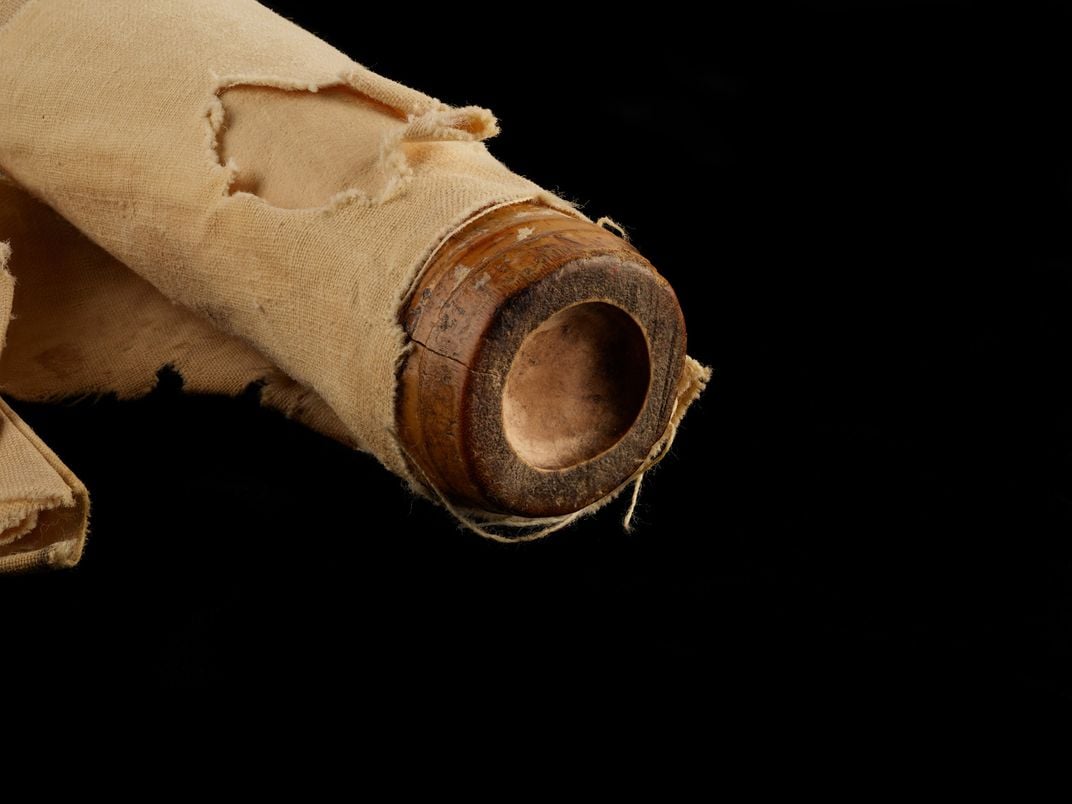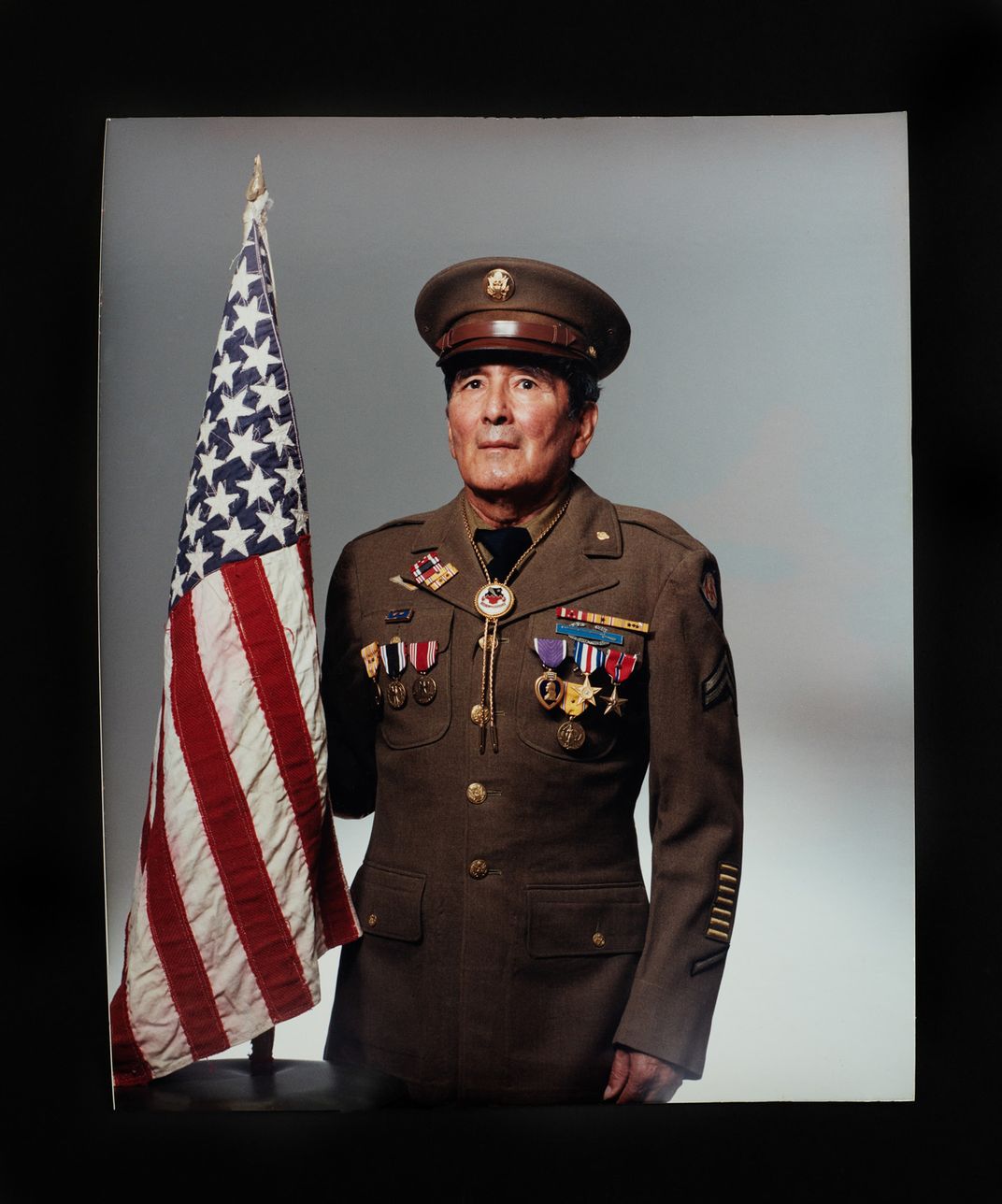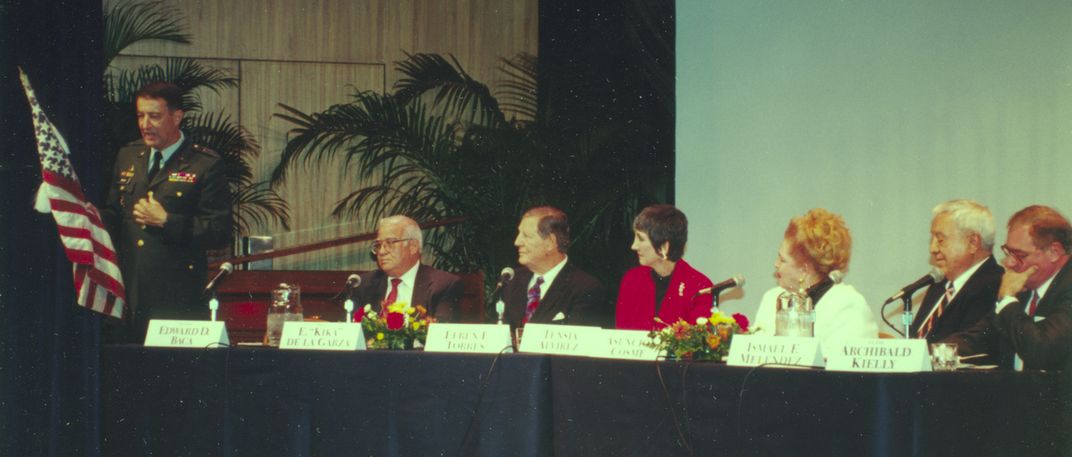NATIONAL MUSEUM OF AMERICAN HISTORY
How This WWII Flag Fulfilled a General’s Dying Wish
Private José Quintero struggled to create this flag in secret while held as a prisoner of war during World War II
:focal(800x636:801x637)/https://tf-cmsv2-smithsonianmag-media.s3.amazonaws.com/filer_public/a5/e8/a5e8ec0b-b5b1-4820-81f0-07e02370f2cf/rws2021-00269.jpg)
Unassuming at first glance, a U.S. flag that recently joined our museum's collection brings together the remarkable stories of two U.S. soldiers. Private Joseph O. “Jose” Quintero struggled to create the flag in secret while held as a prisoner of war (POW) during World War II. Later, Lt. Gen. Edward D. Baca became the same flag's guardian, carrying it around the world to honor the memory of Quintero and his fellow veterans.
Joseph O. “Jose” Quintero and his flag
The flag’s story begins with Joseph O. “Jose” Quintero, who enlisted in the U.S. Army in Fort Worth, Texas, in January 1941. As a private, Quintero became part of the 60th Coast Artillery Regiment, where he was assigned to Battery H, a 37mm air defense battery. Captured in 1942 by Japanese forces on the island of Corregidor in the Philippines, Quintero was first held as a prisoner at Cabanatuan Camp Two on Corregidor, then later sent on a voyage on the Taga Maru–a “Hell Ship.” (During the war, many of the ships used by Japanese forces to transport POWs gained the moniker "Hell Ships" because of their inhuman, often deadly, conditions. These ships were also unmarked, and many were sunk by Allied attack). During the Taga Maru’s journey back to Japan, Quintero survived emergency surgery for appendicitis performed by fellow prisoners, who were forced to use a razor blade and two spoons to complete the operation. Quintero spent the rest of the war surviving the trials of living in a POW camp in Japan—Niigata Labor Camp 5B. In the camp, he was assigned to work in the hospital area and to be a steward in the officer and non-commissioned officers’ mess hall.
Quintero’s wartime experience as a POW was shaped by his upbringing. The son of Mexican American immigrants, Quintero grew up in poverty in Texas. He later recalled that his experiences going hungry as a child prepared him for his experiences as a soldier and a POW. Quintero credited his religious faith with keeping him alive—faith that he would share with his fellow prisoners.
Quintero created the U.S. flag in secret during his time as a POW; the project took him a year to complete. To hide the flag from the Japanese guards, he kept it wrapped in a piece of canvas under his bunk and worked at night with a Canadian soldier, a double amputee and fellow POW who had access to the camp’s sewing room.
Although Quintero’s flag has many familiar features—48 stars and 13 stripes, the standard in World War II—a close inspection hints at its origins in a POW camp. The flag has uneven zig-zag stitches that cross the stars in the field of blue. Its white material is noticeably thin. According to Quintero, the white material was a bed sheet used by the POWs in the Japanese prison camp. The flag’s red stripes were taken from a red wool blanket that belonged to another soldier; its blue field from a pair of Filipino dungarees. The red dye from the stripes has bled into the white stripes a bit, where the fabric may have gotten wet or damp. The entire flag is attached to a small pole or staff designed to be held in hand. The pole was originally a stick that Japanese guards used to discipline and beat prisoners. The pole’s white cordage was from the supply parachutes that were dropped prior to the prisoners being picked up by U.S. forces at the end of the war. The tan wrapping at the handle end of the pole appears to be old medical tape. A piece of rope from a tent cord was used for the hoist rope which you can see at the top of the flag, where it attaches to the top of the bamboo pole.

Creating the flag was a dangerous endeavor. Quintero and his fellow prisoners would have been punished, possibly even killed, if their work had been discovered by their Japanese guards. Why did they do it? In a statement made to the Committee on the Judiciary in 1999, Lt. Gen. Edward D. Baca attributed Quintero's dedication to his love for his country and his fellow soldiers:
Jose so loved his country, that he looked for a way to express that love. He wanted to honor his friends and to make a symbol for himself to prove that he had not been "broken" in spirit. Most of all he wanted to honor what he calls "the real heroes of the war," those who made the ultimate sacrifice, those dying all around him. He began a project which would have meant a torturous death to him had he been caught.
Weeks before the end of the war (as described in the book Don Jose: An American Soldier’s Courage and Faith in Japanese Captivity by Ezequiel L. Ortiz and James McClure, based upon interviews with Quintero), the prisoners in the camp heard the rumbling of planes overhead. Realizing the sound came from U.S. bombers, Quintero took out his flag and waved it in the air. The pilots recognized the flag by tipping their wings, to acknowledge the Americans. By doing this, Quintero risked his own life, but he helped save the lives of all his fellow prisoners.

Two men united in faith and courage to tell the story of Hispanic veterans
Edward Baca, born in Santa Fe, New Mexico, was from a family whose service in the U.S. military went back to the Civil War. He enlisted in the New Mexico National Guard in 1956 and later volunteered for service in Vietnam. Baca rose through the ranks of the National Guard, receiving a promotion to Lt. General and serving as the first Latino Chief of the National Guard Bureau.
Inspired in part by the work of his father and uncle, both World War II veterans, Baca was committed to telling the story of the soldiers of the New Mexico National Guard units, so many of whom made up the American units at Bataan in the Philippines. Many of these soldiers were killed in action, died of wounds, or died during imprisonment, never to return home. During his National Guard service, Baca helped many of the Bataan and Corregidor veterans secure the medals they were due. When he became Chief of the National Guard Bureau, Baca awarded Quintero the New Mexico Medal of Valor with Palm.
Little did Baca know that after the event, Quintero had a presentation to make to Baca. Quintero gave Baca the flag he and his fellow soldiers had created in secret during World War II—and asked the younger soldier to tell their story all over the United States. Baca accepted Quintero's charge. In the years that followed their meeting, Baca told the linked stories of New Mexico’s military history, Hispanic soldiers’ service in World War II, and Quintero’s flag in every state and territory in the United States (and eventually all seven continents in the world). At each stop, Baca emphasized Quintero’s strength, character, and incredible patriotism that ultimately saved hundreds of lives.

To the Smithsonian
In 1995, at a World War II commemoration event for Hispanic veterans, General Baca told the story of the Bataan veterans from New Mexico and shared the story of Quintero and his flag. After he was finished, the moderator, Tensia Alvirez (head of the museum’s public relations at the time) asked the general if he would consider donating the flag to the Smithsonian. Baca replied that he wanted to tell the story all over the United States—but said “when I am finished with my service, I will consider presenting to the Museum.”
After the program, I handed General Baca my business card, assured him that we were interested in the flag, and told him that I would be the curator to help receive it for the collections. In 2002, he reached out to me again to check to see if we were still interested. He let me know he was still not done telling the story of Quintero and his flag to the nation, but that he would keep in touch. True to his word, in 2012, I received an email from Baca’s executive officer, Mike Gonzales, asking for a phone conference call with the general. We spoke about the flag, his continued work, and our continued interest in receiving the flag.
My final email and call with Baca in July 2020 were also coordinated by Gonzales, who spoke of the general as his mentor and friend. It had been many years since our last conversation and Baca was in poor health, undergoing chemotherapy treatment for an aggressive form of leukemia. Despite not knowing if I was still at the museum, or if the museum would still be interested in the flag, Gonzales promised the general he would do everything in his power to get in touch with me. When they reached me, and I spoke to Baca, he let me know he was finally ready for the flag to come to the Smithsonian. Baca passed away on September 15, 2020. The flag arrived within a year of his passing, fulfilling his promise of honor and trust that the Smithsonian would continue to tell the story. The Taos News obituary for Baca emphasized the vital role that Baca’s love for country played in his life:
He loved the United States and he loved New Mexico. He felt he was part of a long line of soldiers, part of a tradition. He said it was important not to take the country for granted.
Today, this flag has become part of our museum's collections, fulfilling the dying wish of a general to tell the story of Jose Quintero, his flag, and his service to the United States.
This post was originally published on the National Museum of American History's blog on November 10, 2022. Read the original version here.
